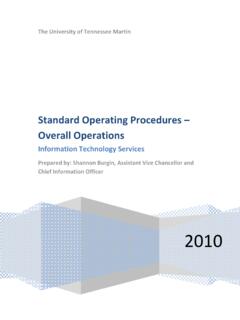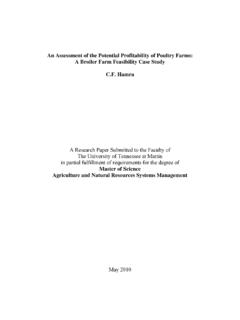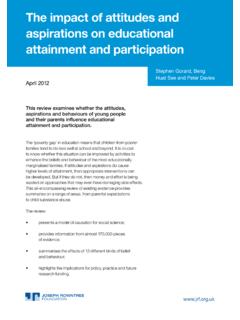Transcription of EMPLOYEE ATTITUDES AND JOB SATISFACTION
1 Happy employees are productive employ-ees. Happy employees are notproductiveemployees. We hear these conflicting state-ments made by HR professionals and man-agers in organizations. There is confusionand debate among practitioners on the topicof EMPLOYEE ATTITUDES and job SATISFACTION even at a time when employees are increas-ingly important for organizational successand competitiveness. Therefore, the purposeof this article is to provide greater under-standing of the research on this topic andgive recommendations related to the majorpractitioner knowledge indicated indirectly in a study of HRprofessionals (Rynes, Colbert, & Brown,2002), as well as based on our experience,the major practitioner knowledge gaps inthis area are: (1) the causes of EMPLOYEE at- titudes , (2) the results of positive or negativejob SATISFACTION , and (3) how to measure andinfluence EMPLOYEE ATTITUDES .
2 Within eachgap area, we provide a review of the scien-tific research and recommendations forpractitioners related to the research find-ings. In the final section, additional recom-mendations for enhancing organizationalpractice in the area of EMPLOYEE attitudesand job SATISFACTION are described, alongwith suggestions for evaluating the imple-mented beginning, we should describewhat we mean by EMPLOYEE ATTITUDES and jobsatisfaction. Employees have ATTITUDES orviewpoints about many aspects of their jobs,their careers, and their organizations. How- EMPLOYEE ATTITUDES AND JOBSATISFACTIONH uman Resource Management,Winter 2004, Vol. 43, No. 4, Pp. 395 407 2004 Wiley Periodicals, Inc.
3 Published online in Wiley InterScience ( ).DOI: M. Saari and Timothy A. JudgeThis article identifies three major gaps between HR practice and the scientific research in thearea of EMPLOYEE ATTITUDES in general and the most focal EMPLOYEE attitude in particular jobsatisfaction: (1) the causes of EMPLOYEE ATTITUDES , (2) the results of positive or negative job satis-faction, and (3) how to measure and influence EMPLOYEE ATTITUDES . Suggestions for practition-ers are provided on how to close the gaps in knowledge and for evaluating implemented prac-tices. Future research will likely focus on greater understanding of personal characteristics, suchas emotion, in defining job SATISFACTION and how EMPLOYEE ATTITUDES influence organizationalperformance.
4 2004 Wiley Periodicals, to: Lise M. Saari, IBM Corporation, Global Workforce Research, North Castle Drive MD149, Armonk, NY 10504-1785, tel: 914-765-4224, HUMANRESOURCEMANAGEMENT, Winter 2004ever, from the perspective of research andpractice, the most focal EMPLOYEE attitude isjob SATISFACTION . Thus, we often refer to em-ployee ATTITUDES broadly in this article, al-though much of our specific focus will con-cern job most-used research definition of jobsatisfaction is by Locke (1976), who definedit as .. a pleasurable or positive emotionalstate resulting from the appraisal of one s jobor job experiences (p. 1304). Implicit inLocke s definition is the importance of bothaffect, or feeling, and cognition, or we think, we have feelings about whatwe think.
5 Conversely, when we have feelings,we think about what we feel. Cognition andaffect are thus inextricably linked, in our psy-chology and even in our biology. Thus, whenevaluating our jobs, as when we assess mostanything important to us, both thinking andfeeling are 1 The causes of EmployeeAttitudesThe first major practitioner knowledge gapwe will address is the causes of EMPLOYEE at- titudes and job SATISFACTION . In general, HRpractitioners understand the importance ofthe work situation as a cause of EMPLOYEE at- titudes , and it is an area HR can help influ-ence through organizational programs andmanagement practices. However, in the pasttwo decades, there have been significant re-search gains in understanding dispositionaland cultural influences on job SATISFACTION aswell, which is not yet well understood bypractitioners.
6 In addition, one of the mostimportant areas of the work situation to in-fluence job SATISFACTION the work itself isoften overlooked by practitioners when ad-dressing job InfluencesSeveral innovative studies have shown theinfluences of a person s disposition on jobsatisfaction. One of the first studies in thisarea (Staw & Ross, 1985) demonstratedthat a person s job SATISFACTION scores havestability over time, even when he or shechanges jobs or companies. In a relatedstudy, childhood temperament was found tobe statistically related to adult job satisfac-tion up to 40 years later (Staw, Bell, &Clausen, 1986). Evidence even indicatesthat the job SATISFACTION of identical twinsreared apart is statistically similar (seeArvey, Bouchard, Segal, & Abraham, 1989).
7 Although this literature has had its critics( , Davis-Blake & Pfeffer, 1989), an ac-cumulating body of evidence indicates thatdifferences in job SATISFACTION across em-ployees can be traced, in part, to differencesin their disposition or temperament (House,Shane, & Herold, 1996).Despite its contributions to our under-standing of the causes of job SATISFACTION ,one of the limitations in this literature is thatit is not yet informative as to how exactly dis-positions affect job SATISFACTION (Erez, 1994).Therefore, researchers have begun to explorethe psychological processes that underlie dis-positional causes of job SATISFACTION . For ex-ample, Weiss and Cropanzano (1996) sug-gest that disposition may influence theexperience of emotionally significant eventsat work, which in turn influences job satis-faction.
8 Similarly, Brief (1998) and Mo-towidlo (1996) have developed theoreticalmodels in an attempt to better understandthe relationship between dispositions and this theoretical develop-ment, Judge and his colleagues (Judge &Bono, 2001; Judge, Locke, Durham, &Kluger, 1998) found that a key personalitytrait, core self-evaluation, correlates with (isstatistically related to) EMPLOYEE job satisfac-tion. They also found that one of the primarycauses of the relationship was through theperception of the job itself. Thus, it appearsthat the most important situational effect onjob SATISFACTION the job itself is linked towhat may be the most important personalitytrait to predict job SATISFACTION core self-evaluation.
9 Evidence also indicates thatsome other personality traits, such as extra-version and conscientiousness, can also in-fluence job SATISFACTION (Judge, Heller, &Mount, 2002).These various research findings indicatethat there is in fact a relationship betweendisposition or personality and job satisfac-Evidence evenindicates thatthe jobsatisfaction ofidentical twinsreared apart isstatisticallysimilar. EMPLOYEE ATTITUDES and Job SATISFACTION 397 Even thoughorganizationscannot directlyimpactemployeepersonality, theuse of soundselectionmethods and agood matchbetweenemployees andjobs will ensurepeople areselected andplaced into jobsmostappropriate forthem, which, inturn, will helpenhance theirjob Even though organizations cannot di-rectly impact EMPLOYEE personality, the useof sound selection methods and a goodmatch between employees and jobs will en-sure people are selected and placed into jobsmost appropriate for them, which, in turn,will help enhance their job InfluencesIn terms of other influences on EMPLOYEE at- titudes , there is also a small.
10 But growingbody of research on the influences of cultureor country on EMPLOYEE ATTITUDES and job sat-isfaction. The continued globalization of or-ganizations poses new challenges for HRpractitioners, and the available research oncross-cultural organizational and human re-sources issues can help them better under-stand and guide practice (Erez, 1994; House,1995; Triandis, 1994).The most cited cross-cultural work onemployee ATTITUDES is that of Hofstede (1980,1985). He conducted research on employeeattitude data in 67 countries and found thatthe data grouped into four major dimensionsand that countries systematically variedalong these dimensions. The four cross-cul-tural dimensions are: (1) individualism-col-lectivism; (2) uncertainty avoidance versusrisk taking; (3) power distance, or the extentto which power is unequally distributed; and(4) masculinity/femininity, more recentlycalled achievement orientation.
















